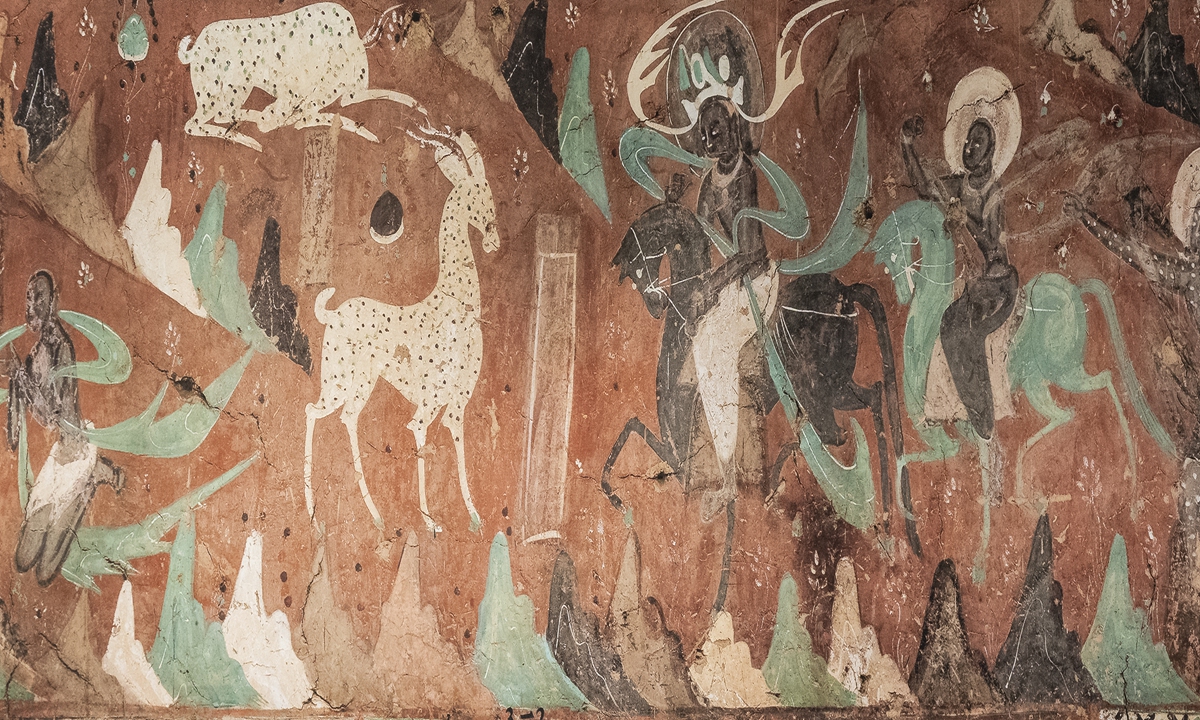
Murals inside Mogao Caves in Dunhuang, Northwest China's Gansu Province Photo: VCG
As many cultural relics in Northwest China's Gansu and Qinghai provinces had suffered damage during the Jishishan earthquake that occurred last week, China's top cultural authority announced Saturday that emergency funds are being distributed for restoration of the damaged relics.
The National Cultural Heritage Administration (NCHA) noted that efforts are under-way in both provinces to "guarantee the timely restoration of affected cultural relics."
The epicenter of the 6.2-magnitude earthquake that occurred on December 18 in Jishishan county, Gansu, was near the province's border with Qinghai. The quake caused varying degrees of damage to both movable and immovable cultural relics in the two provinces.
NCHA said that in Gansu, 24 immovable cultural relics suffered varying degrees of damage, primarily in the form of cracked walls, fallen bricks, and displaced tiles, while no collapses have been reported.
Attention has been particularly drawn to the Lajia Ruins in Qinghai, often referred to as the "Eastern Pompeii." This disaster-related site reflects the history of a large-scale earthquake and its secondary disasters that occurred approximately 4,000 years ago.
The assessment of the damage to the cultural relics at the Lajia Ruins and its museum is still ongoing, the NCHA noted, with related artifacts being safely packed and relo-cated. But a news report from Jiemian News on Thursday indicated that damage at the ruins museum includes cracked walls, fallen bricks and tiles, while more than half of the artifacts, mainly pottery, jade items, and bone artifacts, have been damaged.
Last week's 6.2 magnitude earthquake also caused "sand boils" in Jintian and Caotan, two villages in Qinghai's Minhe county, only about five kilometers away from the Lajia Ruins. The "sand boils" led to the destruction of many houses, which was re-garded by experts as a "reappearance" of the disaster that occurred thousands of years ago.
"The sand boils in these two villages were very close to the Lajia Ruins, which were also destroyed by a massive ancient earthquake and mudflows. This time's disaster could be referred to as a recurrence," Beijing-based archaeologist Zhang Hui told the Global Times on Sunday.
In Jishishan county, the earthquake's epicenter, the local museum has reported damage to 11 colored pottery artifacts, while the rest of the collection remains intact. Near the county, the Bingling Temple Grottoes, the country's first batch of key-protected cultural relics, reported that it had cracks in the walls of the protective buildings, but the main cultural relics inside the grottoes, including statues, murals, and niches, re-mained undamaged.
Jiang Siwei, director of the Dazu Rock Carvings Research Institute, told the Global Times that the current restoration of grottoes are usually the most primitive remedy, which is to repair the cracks simply with human hands. For example, it usually takes about a month to repair a two-meter-long crack."
"There is no way to completely avoid cracking of those stone-carved statues. We can only do our best to protect them at normal times, such as by controlling the types of vegetation around, which can maintain the balance of air humidity to keep them in the best state," Jiang said.
While the Bingling Temple Grottoes are temporarily closed, the Dunhuang Mogao Caves and Maiji Mountain Grottoes,which are about 1,200 kilometers and 400 kil-ometers respectively away from Jishishan, were not affected by the earthquake, as Hongxing News reported.
Xin Tong, a Beijing tourist who landed in Dunhuang right after the earthquake, told the Global Times on Sunday that her travel group and itinerary to the Mogao Caves hadn't been canceled.
In the meantime, precautionary measures, including the closure of collapsed sections, the installation of warning lines and signs are being implemented in at-risk areas in the two provinces. Vigilant monitoring of potential secondary disasters is ongoing to prevent further damage, said the NCHA.
URL: https://www.seeglobalnews.com/read-2925.html